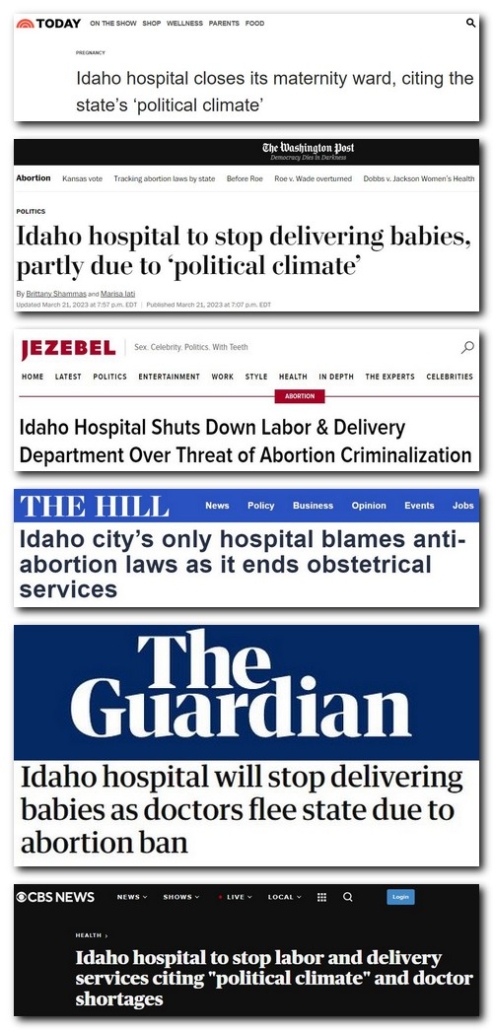Idaho hospital ends L&D services due to decreasing patient volumes; media blames abortion bans
Bonner General Health (BGH), a hospital in Sandpoint, Idaho, has announced it is ending it’s labor and delivery services. You may have seen headlines like these:

The Dobbs decision overturned Roe v. Wade, which had been around since 1973. That means legislatures across the country are grappling with changes to a decades-long legal status quo. It wouldn’t surprise me if there have been trigger laws written too ambiguously or opaquely, at least initially leading to miscommunications, confusion, and disruptions in medical care. To the extent that’s actually the case, legislators must fix those issues. Laws restricting abortion should be very clear and unambiguous, and should include strong exceptions for when a woman is in danger.
However, media narratives such as the headlines above, claiming catastrophic effects of abortion restrictions, are often at best incomplete and at worst transparently deceptive compared to the information actually available. The media coverage of BGH’s L&D closure suggests doctors are no longer working at the hospital because of abortion bans. But the hospital’s own press release paints a broader picture, stating multiple reasons for closing L&D.
The first reason they list is a loss of pediatricians:
Without pediatrician coverage to manage neonatal resuscitations and perinatal care, it is unsafe and unethical to offer routine Labor and Delivery services.
Pediatricians are not OBGYNs. The care they provide is exclusively for born children. Insufficient pediatrician coverage isn’t a result of abortion restrictions. But then why is it happening?
The press release cites a second reason which may explain: decreasing patient volumes and changing demographics.
The number of deliveries at BGH has continued to decrease yearly. … There are many reasons, including a nationwide decrease in births [and] an older population moving to Bonner County.
Idaho’s abortion restriction didn’t go into effect until the second half of last year, and the state’s Supreme Court didn’t uphold them until a a couple months ago. But BGH has been seeing decreasing patient volumes for years. Sandpoint, Idaho has only 9,000 residents, and they are increasingly an older population. The hospital didn’t have enough patients to afford the L&D department.
Note, too, they listed a third reason for decreasing patient volumes:
Kootenai Health [has] a new, updated unit with Neonatologists and OBs in-house 24/7.
Kootenai Health is the hospital in Coeur d’Alene, Idaho, a city about an hour south of Sandpoint with a population of 56,000. According to BGH, residents of Sandpoint are choosing to deliver at Kootenai Health over BGH because it has a better staffed, more updated L&D unit. If doctors are “fleeing” Idaho due to abortion laws, why isn’t Kootenai Health’s L&D unit struggling to stay open?
Despite BGH discussing multiple more pressing reasons for closing its L&D unit, note only one of the headlines above even mentions any reason other than abortion bans.
Still, after discussing lack of pediatricians and lack of patients, BGH’s press release does go on to list Idaho’s legal and political climate as a reason for closing L&D. The media coverage often quotes the hospital as saying physicians are leaving and recruiting replacements is difficult because of Idaho’s abortion laws. But note the way BGH actually worded this section (emphasis added):
Highly respected, talented physicians are leaving. Recruiting replacements will be extraordinarily difficult. In addition, the Idaho legislature continues to introduce and pass bills that criminalize physicians for medical care…
Physicians are leaving BGH and are difficult to replace largely because of low patient census in Bonner County. BGH lists the political climate as a supplemental reason, after the primary reasons.
But BGH does list the political climate as a factor. Idaho’s anti-abortion legislators have already been working to clarify the parameters around which abortion is restricted.
Around the same time BGH gave their press release, legislators introduced an amendment to the state’s abortion law which was crafted with input from the Idaho medical association. The changes are designed to make abundantly clear what is and isn’t legally considered an abortion in Idaho:
Those new changes define what is not an abortion. They include the removal of a dead unborn child, the removal of an ectopic pregnancy, and the treatment of a woman who is no longer pregnant.
The amendment also changes the life-threatening clause, it states: “if a physician has reasonable judgment that an abortion was necessary to treat a physical condition of a woman that if left untreated would be life-threatening.”
The amendment’s sponsor states the amendment “clarifies that the woman’s life is also very important to us and that if it’s a life-threatening situation, then the physician has the ability to make a determination.”



